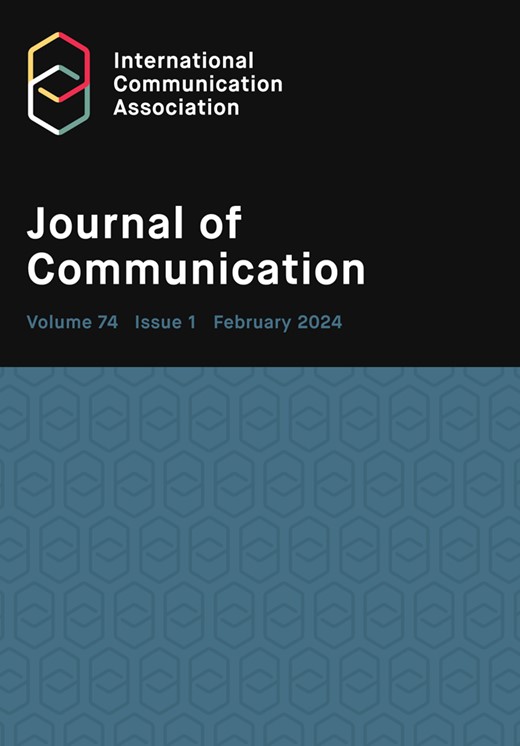即时信息时代的人际沟通与人际关系满意度
IF 6.1
1区 文学
Q1 COMMUNICATION
引用次数: 0
摘要
目的:本研究的总体目标是探讨即时通讯应用程序对人际沟通和关系动态的影响。研究方法:本研究采用桌面研究方法。案头研究指的是二手数据或无需实地考察即可收集到的数据。案头研究基本上是从现有资源中收集数据,因此与实地研究相比,案头研究通常被认为是一种低成本技术,因为主要成本涉及执行人员的时间、电话费和目录。因此,本研究依赖于已出版的研究、报告和统计数据。这些二手数据可通过在线期刊和图书馆轻松获取。研究结果:研究结果表明,在即时通讯应用程序对人际沟通和关系动态的影响方面,存在着背景和方法上的差距。初步的实证审查显示,虽然即时通讯增加了夫妻间的联系和即时性,但也导致了界限模糊,以及由于期望即时回应而产生的潜在压力。通过即时通讯进行的频繁交流增强了关系纽带,但由于缺乏非语言线索,也会造成沟通不畅。这种影响因个体差异和关系背景而异,年轻夫妇和异地夫妻受益更多。研究得出结论,要保持较高的关系满意度,就必须在即时通讯与面对面交流之间取得平衡。对理论、实践和政策的独特贡献:社会存在理论、媒体丰富性理论和使用与满足理论可用于今后有关即时信息对人际沟通影响的研究。该研究建议扩展传统的沟通理论,将数字的细微差别纳入其中,为人际关系咨询师制定应对即时信息挑战的实用策略,并实施政策变革以支持健康的数字沟通实践。研究还建议开展提高数字素养的教育计划,鼓励进一步研究即时通讯使用中的人口统计学差异,并将研究结果纳入人际关系干预计划。这些建议旨在加强理论理解、实际应用和政策制定,以促进数字时代更健康、更令人满意的人际关系。本文章由计算机程序翻译,如有差异,请以英文原文为准。
Interpersonal Communication and Relationship Satisfaction in the Era of Instant Messaging
Purpose: The general objective of this study was to examine the impact of instant messaging apps on interpersonal communication and relationship dynamics.
Methodology: The study adopted a desktop research methodology. Desk research refers to secondary data or that which can be collected without fieldwork. Desk research is basically involved in collecting data from existing resources hence it is often considered a low cost technique as compared to field research, as the main cost is involved in executive’s time, telephone charges and directories. Thus, the study relied on already published studies, reports and statistics. This secondary data was easily accessed through the online journals and library.
Findings: The findings reveal that there exists a contextual and methodological gap relating to instant messaging apps on interpersonal communication and relationship dynamics. Preliminary empirical review revealed that while instant messaging increased connectivity and immediacy between couples, it also led to blurred boundaries and potential stress due to expectations for immediate responses. Frequent communication via IM enhanced relationship bonds but also introduced miscommunications due to the lack of non-verbal cues. The impact varied based on individual differences and relationship contexts, with younger and long-distance couples benefiting more. The study concluded that balancing IM with face-to-face communication was essential for maintaining high relationship satisfaction.
Unique Contribution to Theory, Practice and Policy: The Social Presence Theory, Media Richness Theory and Uses and Gratification Theory may be used to anchor future studies on the impact of instant messaging on interpersonal communication. The study recommended expanding traditional communication theories to incorporate digital nuances, developing practical strategies for relationship counselors to navigate instant messaging challenges, and implementing policy changes to support healthy digital communication practices. It also suggested educational programs to enhance digital literacy, encouraged further research on demographic variations in IM use, and integrating findings into relationship intervention programs. These recommendations aimed to improve theoretical understanding, practical application, and policy development to foster healthier and more satisfying relationships in the digital era.
求助全文
通过发布文献求助,成功后即可免费获取论文全文。
去求助
来源期刊

Journal of Communication
COMMUNICATION-
CiteScore
11.60
自引率
5.10%
发文量
41
期刊介绍:
The Journal of Communication, the flagship journal of the International Communication Association, is a vital publication for communication specialists and policymakers alike. Focusing on communication research, practice, policy, and theory, it delivers the latest and most significant findings in communication studies. The journal also includes an extensive book review section and symposia of selected studies on current issues. JoC publishes top-quality scholarship on all aspects of communication, with a particular interest in research that transcends disciplinary and sub-field boundaries.
 求助内容:
求助内容: 应助结果提醒方式:
应助结果提醒方式:


